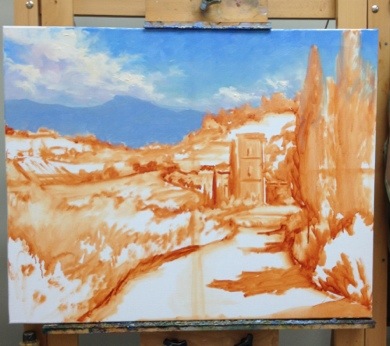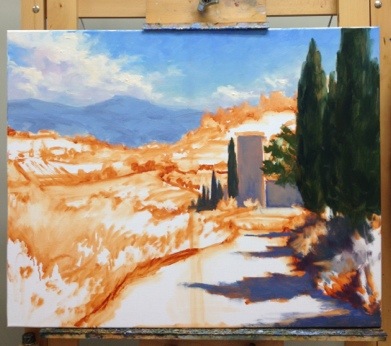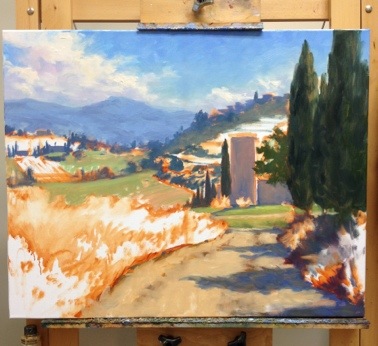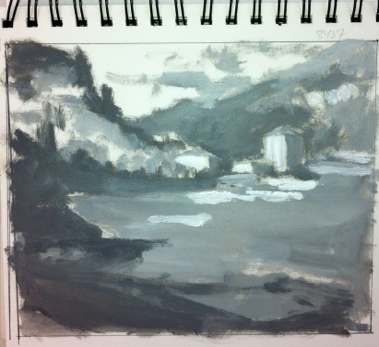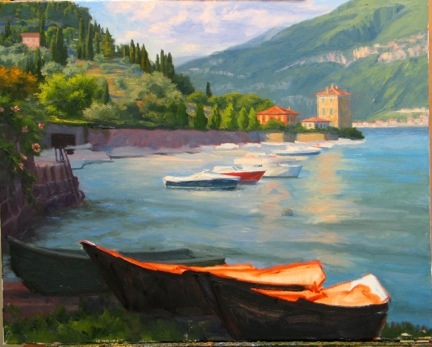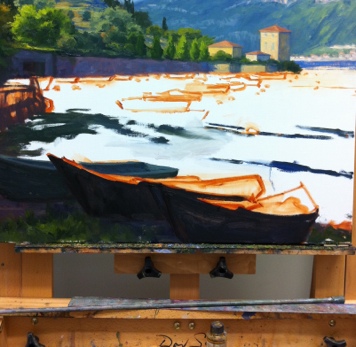Following up from my prior WIP, here is the final painting. This is a view of Bellagio from a hike we took up to Villa Serbelloni. The villa is now maintained by the Rockefeller Foundation, who uses it as a retreat for the Bellagio Study and Conference Center for artists and writers (wouldn't that be nice?) For this reason, we couldn't go inside the villa when we visited, but we could tour the grounds, which offers gorgeous views over Bellagio.

"Bellagio From Above"
Oil on Linen, 20x16"
SOLD!
Both this piece and my previous Lake Como painting, were done without the use of solvents or any other medium other than small amounts of walnut oil to clean brushes and thin paint when necessary. But even when used judiciously, the walnut oil served to slow drying considerably. At present this is not a huge problem, as I am spending most of my time painting/renovating/preparing home and life for the new baby! But it does change the nature of things and the overall result became more impressionistic due both to the behavior of the paint, and probably also the gaps in my working sessions.
I know that an oil painting requires a certain length of time for all of the layers to fully dry (sometimes as much as 6 months or a year.) But normally the top layers will dry to the touch in about a week's time. Not so with the walnut oil method, which seems to require at least an additional week to my usual handling time.
Maybe it's just that my painting habits are not particularly suited for this method, or maybe I just need to get used to new ways of doing things. Overall, except at the very beginning stage, I don't paint in thin layers. In fact, while I don't lay it on with a palette knife, I do paint passages that are relatively thick and juicy. But oddly, I experience the most difficulty in the lay-in, (early stage) which I am used to having set up rather quickly.
First of all, in order to follow the "fat over lean" rule, I have been trying not to make the paint too "fat", too soon. So I keep the walnut oil I use in my initial lay-in stage very spare. The result is that instead of a thinly painted initial sketch and color block-in, I find myself with trying to move paint around that has a definite drag and is less fluid. The lay-in becomes more often a "rub-in" with a rag or a "scrub-in" with an old brush, and the edits and corrections are very hard to lift off the canvas.
On the other hand, if I use more walnut oil at this stage, the paint can get too smeary and unmanageable for successive layers, not to mention less stable (with any medium you use, you should only use no more than 20% total volume when mixed directly into the paint, and I usually err on the side of caution and use rather less than that.)
One solution may be to use a runnier paint in the lay-in stage. M. Graham walnut oil paints are such a paint. I do have a few tubes on hand, as I've tried them in the past. As much as I wanted to like them, I normally prefer more body to my paints. But they might just work for my purposes now--but still probably just in the initial stage only. (Incidentally, it's perfectly okay to mix walnut oil with linseed oil based paint, so even if you want to paint solvent-free, you do not need to buy their paints exclusively.)
Aside from walnut oil to thin, there are other oils to try. Linseed oil is commonly used by artists, both in mixtures of ground paint and in various mediums. And while both linseed and walnut oils are considered to be "drying oils", linseed tends to be the faster-drying of the two. However, I seem to read a lot about how linseed oil tends to yellow over time. Maybe this is an exaggerated worry, but a quick look at experiments like this one swayed me to first try the walnut oil over linseed.
So, to sum up from this layperson's perspective, some of the pros of using walnut oil to thin/clean are:
- Non-yellowing
- Non-toxic/ solvent-free painting (though other oils can also serve to achieve the same thing.)
- Odorless
- Does not evaporate like solvents, so it seems fairly long-lasting
- Conditions brushes nicely
Cons:
- Walnut oil is expensive! (If you are only using oil to clean your brushes, you could probably get by with a less expensive oil.)
- Slows drying considerably (this could actually be a "pro", depending on your painting technique.)
- Compared to solvent, it requires using more brushes and/or more wiping of brushes between colors in order to keep the color clean.
- Walnut oil is expensive!







